Infographic - 5 Common Misconceptions Regarding Learning Chinese
24.10.2013 08:08:25
Some misunderstandings are quite amusing, like this joke:
I said to my wife last night, "I fancy a takeaway."
She said, "Are you talking Chinese?"
I said, "No, did it sound Chinese?"
Misunderstandings or misconceptions can be fun, but they're not always that great. Below you'll find 5 common misconceptions regarding the Chinese language. I hope the associated illustrations will amuse you, in which case these misconceptions will be fun after all.
This is all part of the "Infographic on Chinese pronunciation and pinyin in plain English".
Myth: Singing In Chinese Is Impossible
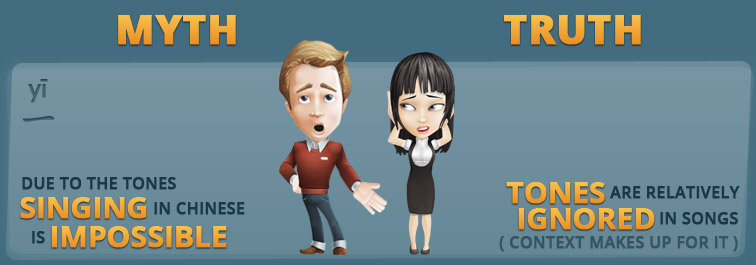
Some new learners of Chinese reason that singing in Chinese is impossible, since all the tones for each word are already fixed, giving no leeway for singing.
That's just outright wrong.
There are at least two simple reasons why singing is possible in Chinese.
- If the melody requires a certain word to be sung in a tone different from its original tone, then melody will overrule and the syllable's tone will be ignored relatively.
- The tones in mandarin Chinese are not fixed absolutely. If they were, it would be impossible to convey feelings and emotions through tone of voice, modulation, sense stress and so on. In daily speech, words are emphasized naturally by stretching some tones and shortening others. So while tones are very important in Chinese, they can still be "bent", and this is done to a great extent in Chinese songs.
Myth: Pinyin Is Like Chinese Pidgin
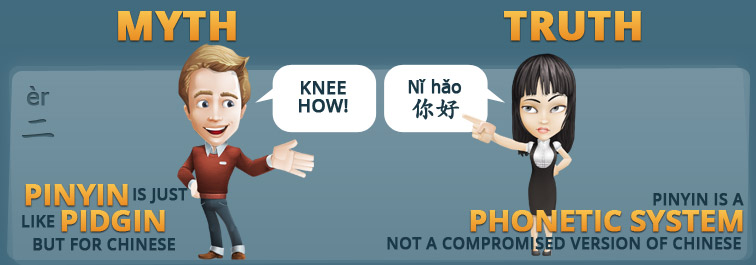
This myth is a sad result of the otherwise great pinyin system. Some new learners of Chinese think, when they see pinyin, that this looks so familiar, that they start treating it like some sort of Chinese pidgin. Please don't!
Pinyin is nothing like pidgin. Pinyin is a phonetic system, it isn't a language. As a Chinese learner progresses he will realize that while learning pinyin might have been the primary basis for his conversational skills, learning Chinese characters will give him the real understanding of the language needed to develop his conversational skills further.
Pidgin is the resulting language, evolving out of the simplified use of a certain language, English for example. The learner has his own language, and there is the language he is learning (perhaps English). If he and a number of other learners don't learn the new language properly, then a third hybrid language evolves. Such language is called "pidgin". You wouldn't want to speak "Chinese pidgin", unless of course, all you aim at is to be understood by your fellow Chinese-learning classmates.
Myth: J Is Pronounced Exactly As In Jeep
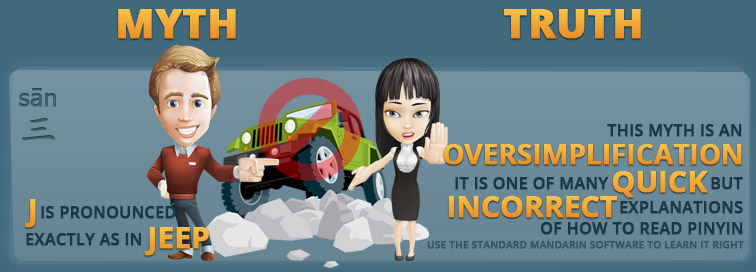
The myth that J is pronounced exactly as J in Jeep is a very common misconception found on the internet. This myth is really an oversimplification. It really isn't that simple. True, it is a quick way to learn, but it is also incorrect.
If you put in the little extra effort and get this pronunciation right, from the beginning, then it will serve you well! In particular because the pronunciation of J is closely linked to the pronunciation of Q and X. These can be quite difficult to learn, so don't settle with an average pronunciation of J, when it could serve as a stepping stone to mastering more complex sounds.
Get the Standard Mandarin software to learn it right. It has a great section on anatomy and a pronunciation guide, with which you will learn to master Chinese pronunciation. You'll even be more aware of how to produce mandarin sounds, than the native Chinese.
Myth: Chi And Che Is Basically The Same Thing
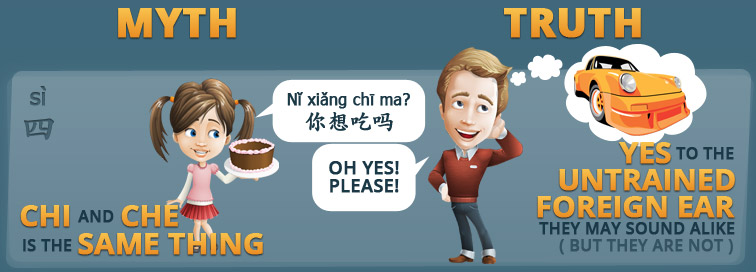
Yes, to the untrained foreign ear CHI and CHE sound alike. The truth is, they are not.
It is true that you may be understood most of the time, even if you're making no distinction between the two sounds. But your speech will seem cluttered and unclear.
Check out the illustration above. Not making clear distinction between these sounds will give cause to more language misunderstandings. The little girl (Daisy) is asking the guy (John) whether he'd like to have some cake. He, though, is unable to hear the difference between CHI and CHE, so in his ears, he is hearing "Are you thinking about a car?"
There is a reason why there are both the syllables CHI and CHE. They do not represent the same sounds.
Myth: Wrong Tone Will Most Likely Result In A Misunderstanding
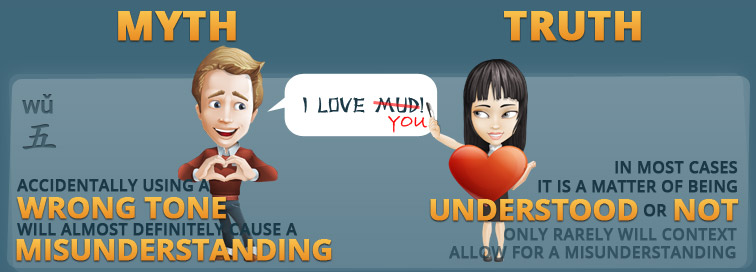
Fortunately this is not the case. Most tonal mistakes don't cause more harm than that the listener needs a little extra time to process the sound before he understands.
The truth is that only in very rare cases, will a tonal mistake allow for any other understanding than the intended. So if you're not understood correctly, chances are you not misunderstood either.
It is still true though, that using a wrong tone may result in a major misunderstanding. If that should happen to you, which it probably will some day, then try and enjoy the fact that you have amused your listener. It is healthy for him to smile or even laugh, and it is healthier for you to find joy in it, rather than be overly worried about making mistakes.
Did you enjoy this walkthrough of the fourth section of the infographic on Chinese pronunciation and pinyin? Check out the entire infographic right here.
If you would like to learn more Chinese pronunciation and pinyin, please download the Standard Mandarin software. You can download it for free here.
Below is the entire fourth section of the infographic.
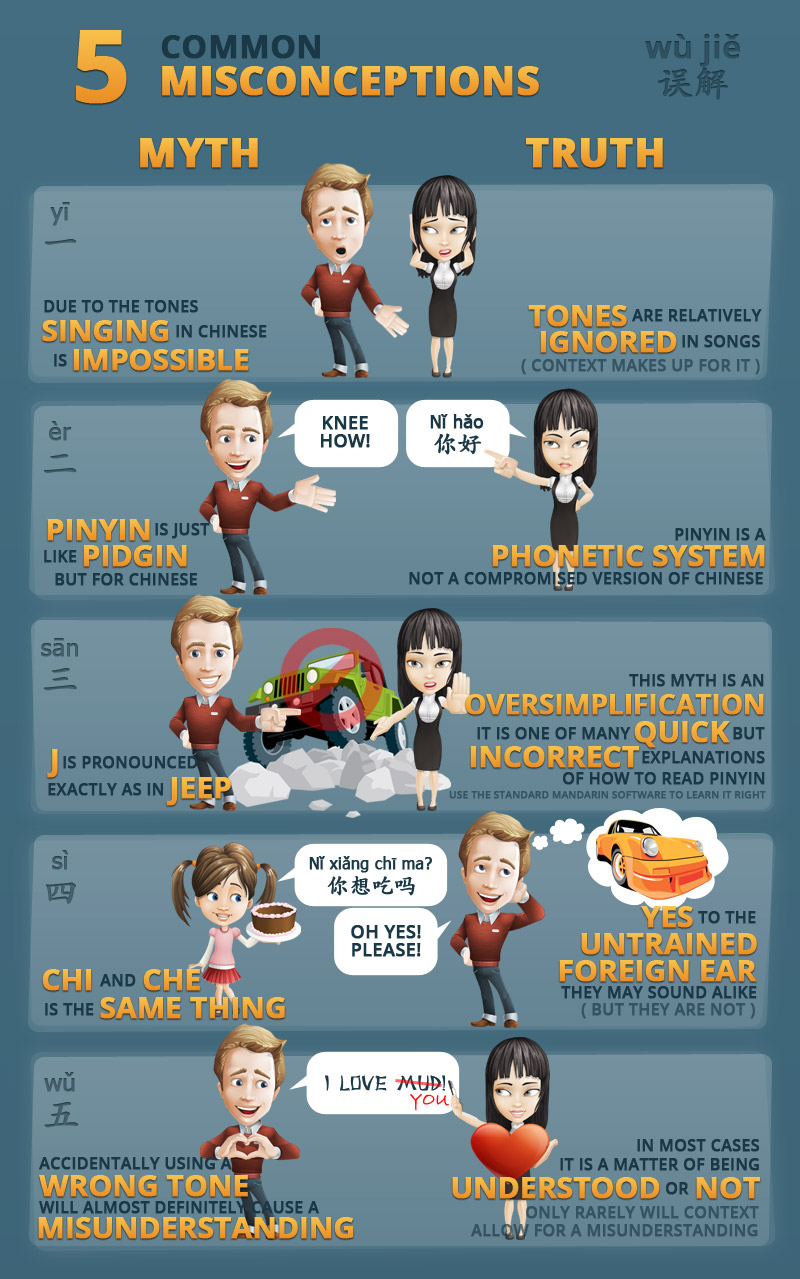

Did you like this page?